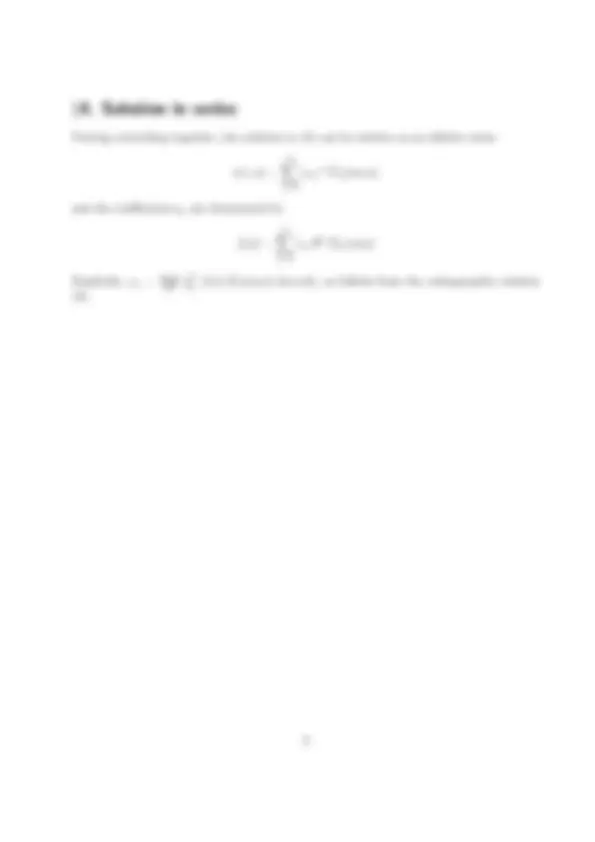



Study with the several resources on Docsity

Earn points by helping other students or get them with a premium plan


Prepare for your exams
Study with the several resources on Docsity

Earn points to download
Earn points by helping other students or get them with a premium plan
Community
Ask the community for help and clear up your study doubts
Discover the best universities in your country according to Docsity users
Free resources
Download our free guides on studying techniques, anxiety management strategies, and thesis advice from Docsity tutors
These notes explore the laplace equation in spherical coordinates and its solutions invariant under rotations. The document derives the laplacian in spherical coordinates and uses the inner product of gradients to prove the result. The text then discusses finding harmonic functions on a sphere using separation of variables, leading to the legendre equation and the legendre polynomials as solutions.
Typology: Study notes
1 / 3

This page cannot be seen from the preview
Don't miss anything!


Let (r, φ, θ) be the spherical coordinates, related to the Cartesian coordinates by
x = r sin φ cos θ, y = r sin φ sin θ, z = r cos φ.
In polar coordinates, the Laplacian ∆ = ∂
2 ∂x^2 +^
∂^2 ∂y^2 +^
∂^2 ∂z^2 becomes
∆ u =
r^2
∂r
r^2
∂u ∂r
r^2 sin φ
∂φ
sin φ
∂u ∂φ
r^2 sin^2 φ
∂^2 u ∂θ^2
Although it is possible to verify (1) directly using the chain rule, we give a simpler proof using the formula
∇u · ∇f =
∂u ∂r
∂f ∂r
r^2
∂u ∂φ
∂f ∂φ
r^2 sin^2 φ
∂u ∂θ
∂f ∂θ
for the inner product of the gradients of two functions, which is quite easy to check. The proof of (1) uses (2), the change of variable formula, and integration by parts, without much calculation: For each smooth function f (x, y, z) which vanishes outside of a bounded region in R^3 , we have ∫∫∫ f ∆u r^2 sin φ dr dφ dθ =
f ∆u dx dy dz change of variables = −
∇u · ∇f dx dy dz integration by parts = −
∫∫∫ (∂u ∂r
∂f ∂r +^
1 r^2
∂u ∂φ
∂f ∂φ +^
1 r^2 sin^2 φ
∂u ∂θ
∂f ∂θ
f
∂ ∂r
r^2 ∂u∂r
sin φ + (^) ∂φ∂
sin φ (^) ∂φ∂u
f
1 r^2
∂ ∂r
r^2 ∂u∂r
sin φ ∂u∂φ
(^2) u ∂θ^2
r^2 sin φ dr dr dφ dθ
Since the above equality holds for every smooth function f vanishing outside some bounded region, (1) follows.
How does one find a function u(r, φ θ) defined on a sphere 0 ≤ r ≤ R of radius R such that
∆u = 0, u(R, φ, θ) = f (φ) (3)
where f (φ) is a (given) function on the boundary of the sphere r = R, expressed in spherical coordinates, which is symmetric about the z-axis? The general procedure of separation of variables says that one should first find harmonic functions of the form F (r) G(φ); these “eigenfunctions” will be parametrized by some discrete parameters.
Separation of variables leads to the system of ordinary equations
d dr
r^2
dF dr
− k F (r) = 0, (4)
and 1 sin φ
d dφ
sin φ
dG dφ
for some k ∈ R. The equation (4) has solutions F (r) = rn, with n ∈ R≥ 0 and k = n(n + 1).
The equation (5) will look a lot better if we use the variable w = cos φ, with 0 ≤ w ≤ 1. Let H(w) be the function in w corresponding to G(φ), so that H(cos φ) = G(φ), then the equation (5) becomes the standard Legendre equation with parameter n:
d dw
(1 − w^2 )
dH dw
Although one does not see any restriction on k at this stage other than n ≥ 0, it turns out that n has to be an integer, otherwise F (r)G(φ) cannot be a well-defined harmonic function on the sphere. This follows from a careful analysis of solutions of (6).
With n being a non-negative integer, the solutions of (6) that behave well at w = ±1 are all multiples of the Legendre polynomial Pn(w), defined by
Pn(w) =
2 n^ n!
dn dwn^
[(w^2 − 1)n] n ∈ Z≥ 0. (7)
Besides being the solution of the Legendre differential equation (6), the Legendre polynomials satisfy the orthogonality relations: ∫ (^1)
− 1
Pm(w)Pn(w) dw =
2 m + 1
δm,n (8)
where δm,n is equal to 0 if m 6 = n, and δm,n = 1 if m = n. To check (8), one uses integration by parts repeatedly. Another way to define the Legendre polynomials is a succinct expression of its generating function:
(1 − wt + t^2 )−^
n=
tn^ Pn(w). (9)
We have P 0 (w) = 1, P 1 (w) = w, P 2 (w) = 3 w
(^2) − 1 2 ,^ P^3 (w) =^
1 2 (5w
(^3) − 3 w),etc. In case you like to
have a good reference for the special functions you encountered in this course, I recommend A Course of Modern Analysis by Whittaker a Watson, an absolute classic.